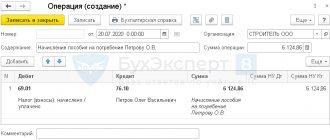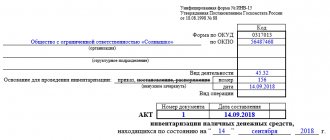Frequency and conditions of inventory
Inventory is one of the accounting methods and acts as a tool to confirm the actual availability and accounting data.
You can consider the concept of inventory in more detail within the framework of studying the discipline: “Accounting Theory”, in the article: “Inventory as a method of accounting.” The use of this method has quite ancient roots and is an integral part of accounting for any enterprise.
Historical summary!
The word “inventory” was first mentioned less than a hundred years ago... Read more
Cash inventory, in turn, provides confirmation of the correct execution of cash transactions, helps identify errors and performs a monitoring function over the safety of funds.
The regulatory framework for conducting an inventory is:
- Federal Law “On Accounting” dated December 6, 2011 N 402-FZ
- Order of the Ministry of Finance of Russia dated July 29, 1998 N 34n (as amended on April 11, 2018) “On approval of the Regulations on accounting and financial reporting in the Russian Federation”
- Guidelines for inventory of property and financial obligations, approved by Order of the Ministry of Finance of the Russian Federation dated June 13, 1995 No. 49
According to these regulatory documents, cases of mandatory inventory are established by law:
- property transferred for rent, as well as during the redemption or sale;
- property of a state or municipal organization in case of its transformation;
- annually all property, the inventory of which was carried out before October 1 before the preparation of annual reports, while certain categories have their own characteristics.
- in cases of change of the financially responsible person (on the day of transfer of cases);
- as a result of theft and damage to property;
- in case of emergencies, natural disasters, fires;
- property of the organization subject to liquidation or reorganization;
Data taken from the article: “Inventory as an accounting method.”
In addition, the enterprise has the right to conduct an unscheduled inventory of the cash register. This type of inventory is carried out within the time frame determined by the management of the organization and is reflected in the order to conduct an unscheduled inventory, indicating the reasons for its implementation. Typical reasons for this may include:
- performing a supervisory function, increasing the responsibility of the cashier;
- identifying the causes of errors in accounting;
- as prescribed by external regulatory authorities.
Who checks cash?
Any check of an enterprise’s cash register is carried out by its internal structure - a special inventory commission. As a rule, such a commission operates in the organization on a permanent basis.
The composition of the commission and its powers are approved by a special administrative act of the organization’s management.
In addition, the legislation provides for the possibility of creating at the enterprise the so-called working audit commissions, which carry out a significant amount of work to simultaneously verify the assets and liabilities of the company.
The activities of the working audit commission of an economic entity are also regulated by the corresponding order of the head.
The following persons are usually included in the commission for inventory of funds of the cash register of an enterprise:
- management representatives;
- accounting staff;
- employees of the division of the organization that carries out financial control and internal audit;
- independent auditors (specialists of companies providing audit services), if there is a need (expediency) for their involvement;
- employees of the enterprise security department;
- specialists from other departments of the organization (if necessary).
If the specific composition of such a commission is approved by order of management, then the absence of one participant is grounds for rejecting the results of its work.
What is being studied?
Checking the cash register involves monitoring the following aspects of compliance with cash discipline:
- Correct accounting of cash transactions, correct formation of correspondence accounts.
- Legality of transactions performed within one transaction.
- Is the check book kept outside the cash register?
- Are the signatures of the chief accountant and manager present on checks that have not yet been completed?
- Timely and correct execution of cash register papers.
- Timely and complete return (deposit) of the balance of unpaid wages to a bank account.
- Validity and documentary evidence of cash records made.
- Does the date of the transaction match the data in the expense order and the cash register?
- Was the spent cash used for its intended purpose?
- Compliance with the cash balance limit.
- Other points of significant importance.
Order of conduct
Checking cash cash implies a certain sequence of actions provided for by the generally binding procedure and logic of inventory.
Thus, at the beginning of this procedure, all relevant documentation certifying the receipt/expense of cash is provided to the audit commission.
The cashiers of the enterprise, who are entities with financial responsibility, confirm in writing that all the necessary papers have been handed over to the inspectors, the available cash has been fully accepted and processed, and the spent (issued) funds have been properly written off and accounted for.
The authorized commission recalculates cash.
The amount received is compared with documented cash accounting information.
In addition, the enterprise’s cash register information is subject to mandatory audit.
An inventory of an enterprise’s cash is carried out by an authorized commission in accordance with the following methodological rules:
- The actual presence of all its approved participants in the commission. This is a necessary condition for recognition of the audit results.
- Any papers drawn up during and after the inventory are completed in at least two copies. This applies to all inventories, protocols, acts.
- Cashiers - in fact, financially responsible entities - necessarily participate in the procedure for recalculating cash.
- Inventory documentation is signed by all members of the commission, as well as by responsible cashiers. Errors and blots are not allowed - they must be corrected correctly (incorrect entries are crossed out and the correct wording is then added above them). Corrections are certified by all members of the commission.
The inventory report, drawn up based on the results of the audit, contains information about the real and accounting cash balances.
Based on the results of comparison of these data, a conclusion is made about their complete compliance or the presence of discrepancies - both upward (surplus) and downward (shortage). The act contains a list of all commission members and their signatures.
Information about the audit is sent to the chief accountant, as well as to the manager, who makes the necessary decisions.
The correspondence of real and accounting information, confirmed by inventory, indicates the high-quality work of the cashier and the correct conduct of cash transactions.
Detection of surplus/shortage indicates the presence of problems that require prompt resolution. Identified discrepancies in the cash balance are subject to adequate accounting. The reasons for detected inconsistencies are clarified and reflected in the inspection report.
Documenting
Checking the cash register of a business entity is accompanied by the execution of a number of mandatory documents.
How to document an inventory in order to carry it out correctly:
- Management order on performing a cash inventory and approving the composition of the audit commission.
- Inventory of cash papers of the cash register and BSO.
- Inventory of cash (helps to establish the fact of compliance or discrepancy between the fact and the accounting).
- A statement that records detected discrepancies between the actual cash balance and cash accounting data.
- An inventory act summarizing the results of the audit (INV-15 standard).
Inventory commission: concept, composition, functions
Before carrying out the inventory, the manager approves the order to carry out the inventory. This order determines the name of the property and obligations subject to verification. In addition, this order contains information about the timing, reason, and composition of the inventory commission. The inventory commission signs this order represented by the chairman of the commission and members of the commission, indicating their positions.
Conceptual help!
An inventory commission is a special commission created at an enterprise for the purpose of reconciling accounting data with actual data.
According to clause 2.2 of the Guidelines for the inventory of property and financial obligations, approved by Order of the Ministry of Finance of the Russian Federation dated June 13, 1995 No. 49, the composition of the commission is permanent. However, when the volume of work is large, working commissions may be created. The composition of the inventory commission is determined by an internal administrative document (order).
The personal composition of the commission includes:
- representative of the management level of the organization;
- accounting employee;
- employee of the audit service within the enterprise/representative of an independent audit company;
- employee of the company's security department, etc.
The absence of even one member of the commission is grounds for canceling the inventory results.
In the absence of personnel changes in the composition of the commission, the regulatory framework does not oblige the enterprise to reissue an order fixing its composition.
The key function of the inventory commission is the control function . This function is implemented through a system of main areas to be checked:
- Storing cash in the cash register according to the established limit. This condition is verified by checking the cash balance in the cash register at the end of the day with the limit amount.
- Availability and relevance of concluded agreements with cashiers on full financial responsibility.
- Compliance with the procedure for filling out the cash book and other cash documents.
- Security of cash. If a surplus or shortage is detected, determine the reasons and identify the culprits.
- Correctness of the assigned account assignment for compliance with the distribution by cost items.
- Checking compliance with the deadlines for accepting primary cash documents for accounting, etc.
Each enterprise that carries out cash transactions is obliged to verify the cash register by conducting an inventory.
What violations are revealed during a cash register inventory?
As the results of the checks show, during the inventory of the cash register, the following violations are revealed.
Failure to comply with the established limit on the cash balance at the institution's cash desk
From January 1, 2013, cash transactions by government institutions are carried out in accordance with Regulation No. 373-P. This document stipulates that in order to conduct cash payments, the institution should establish the maximum allowable amount of cash that can be stored in the place for cash transactions determined by the head of the legal entity after displaying in the cash book (f. 0504514) the amount of cash balance at the end of the working day day (cash balance limit).




